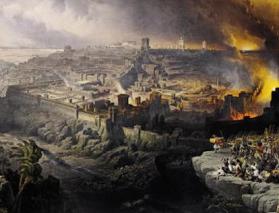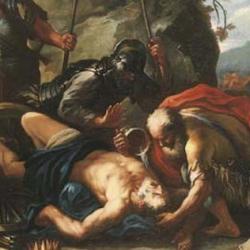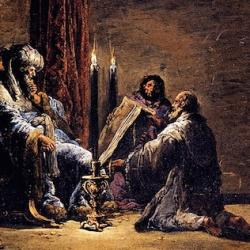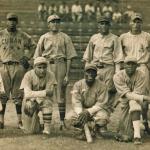The Chronicler’s account of the death of Saul (1 Chronicles 10) is organized in three paragraphs: first, an account of the battle of Mount Gilboa; then, an account of the Philistine seizure of Saul’s body and its rescue by men from Jabeth-Gilead; finally, an editorial evaluation of Saul. The first of these falls out in a fairly neat chiasm:
A. Philistines fight Israel, 10:1
B. Philistines strike Saul’s sons, 10:2
C. Saul’s death, 10:3-5
B’. Death of Saul and his sons, 10:6
A’. Philistines capture cities of Israel and settle in them, 10:7
The central section alternates focus from Saul to his armor bearer and back:
A. Saul wounded by Philistine archers, 10:3
B. Saul asks armor-bearer to kill him, 10:4a
C. Armor bearer refuses, 10:4b
B’. Saul kills himself, 10:4c
C’. Armor bearer kills himself, 10:5
Saul wants his armor bearer to kill him to keep him from being killed by “uncircumcised” Philistines. The passage also turns on a contrast between arrows and swords. Here at least, arrows are the weapons of the uncircumcised, and the sword is the weapon of the circumcised. Significantly, Saul dies by the latter.
Verse 8 forms an inclusio with verses 1-2. It mentions Mount Gilboa, and uses the verb “fall” (Heb. naphal). But the verse is a hinge that also introduces the next sequence of action. Verses 8-12 are organized in a parallel structure that calls attention to the contrast between the Philistines and the men of Jabesh:
A. Philistines find Saul and sons, 10:8
B. Philistines strip, decapitate, and take Saul’s body, 10:9
C. Philistines put Saul’s armor and head in house of Dagon, 10:10
A’. Men of Jabesh hear about Philistine treatment of Saul, 10:11
B’. Men of Jabesh take the bodies of Saul and his sons, 10:12a
C’. Men of Jabesh bring the bodies to bury them in Jabesh, 10:12b
The contrast between verse 9 and 12 is stark. The Philistines send out Saul’s body on parade to proclaim the good news of Dagon; the men of Jabesh mourn.
The final paragraph of the chapter is a modified chiasm:
A. Saul died, 10:13a
B. for the trespass he trespassed, 10:13b
C. because of the word of Yahweh he did not keep, 10:13c
B’. because he inquired of a medium, 10:13d
C’. and did not inquire of Yahweh, 10:14a
A’. So Yahweh killed him, 10:14b
The structure links the trespass with Saul’s consultation with the witch of Endor, and connects his failure to keep the word of Yahweh with his failure to inquire of Yahweh. The text moves from the passive “Saul died” to the more active, and threatening, “He [Yahweh] killed him.” (Note: Saul fell on his sword, but Yahweh killed him; the sword was Yahweh’s weapon against Saul.) The three uses of Yahweh’s name (the only uses in the chapter) come to a crescendo: Saul trespassed against Yahweh; he did not keep Yahweh’s word, and did not seek Yahweh. So He made sure Saul himself was not.
These concluding verses throw light back on the entire chapter. Even in the midst of battle, even when fleeing and wounded, Saul could have sought help from Yahweh. Instead, he sought the help of his armor bearer. Saul provides a negative of the principle of warfare in Chronicles: If you seek him, He will be found; if you forsake Him, He will reject you (1 Chronicles 28:9).















